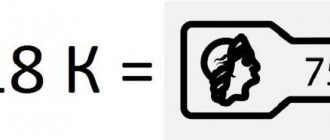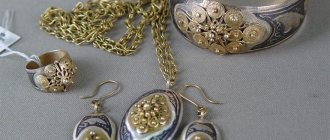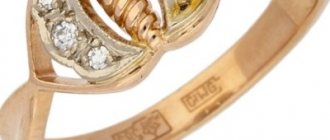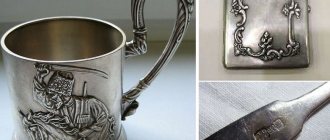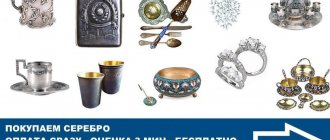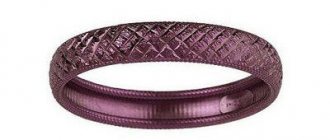- Jewelry with stones
How often have you seen the words “sterling silver” in the description of a product in an online jewelry store? Quite often, we think. Sellers often point out this, thus raising the significance of the decoration. However, for many it remains a mystery what the term “sterling silver” means, whether there are any differences between this type of silver and ordinary silver, and how its authenticity is determined.
We decided to find out what 925 sterling silver is - what is it, are there any differences from simple silver and what are its pros and cons when worn.
What is 925 Sterling Silver?
As we know, pure argentum is unsuitable for creating any objects, be it jewelry, silverware or decorative solutions. Metal that is too soft, too ductile simply does not allow us to produce practical and at the same time attractive products. Therefore, silver is supplemented with various alloys - other metals - to enhance its hardness. These alloy impurities, particularly copper, make silver more durable and easier to work on jewelry without compromising the color.
Sterling silver includes an alloy of pure argentum and ligatures (copper is most often used, less often nickel or zinc). In numbers it looks like this: 92.5% pure silver and 7.5% alloy. So, it turns out that this is 925 sterling silver.
What types of gold are there?
In Russia, precious metals presented on store shelves must be labeled. There are only 7 gold hallmarks. At present, some of them are outdated:
- 375. Precious metal content 37.5%. The rest is a ligature (admixture).
- 500. Contains 50% pure gold. It is rare nowadays.
- 583. Precious metal content 58.3%.
- 585. 58.5% precious metal. This includes 80% of jewelry sold.
- 750. Contains at least 75% pure gold. Widely distributed among exclusive jewelry and diamond jewelry.
- 958. 95.8% precious metal. A small number of such jewelry were produced in past centuries.
- 999. Pure gold. The metal is too soft, so it is not used in jewelry.
As you can see, 925 is not among them.
Origin story
There are several theories about the origin of the name “sterling silver”, and they take us back to the 12th century. In the most popular version (which is also presented in the Encyclopedia Britannica), the ancient English silver coin is called sterling. 1 pound of silver yielded 240 silver sterling. This is where the expression pound sterling comes from. These were the first minted coins made from 925 silver alloy.
According to another version, the word “sterling” comes either from the name of the family of minters from Northern Germany, the Easterlings, or from the name of the region of cities in Germany, Easterling, which were actively trading with England. And, in fact, according to legend, special coins - sterling - began to be minted in Germany especially for trading with the British. These coins were made only from high quality alloy, and gradually they became the standard for English coins. So over time, the alloy used to produce coins came to be called sterling silver.
There is also a third version, according to which the word “sterling” comes from the Old English word “steorling”, which means “coin with a star”. Steorling is the common name for a silver Norman penny, which had images of stars on it.
Price
Demand for the popular alloy Sterling Silver is constantly growing due to its increasing popularity, prices are also becoming higher. The cost of jewelry depends on the country of origin, originality and complexity of the work.
| Type of decoration | Price, rub) |
| Ring | 450-750 |
| Earrings | 580-800 |
| Bracelet | 280-400 |
| Chain | 650-1200 |
Composition and properties of the alloy
The standard sterling alloy is a homogeneous combination of pure silver and copper. But since copper tends to oxidize in air, which affects the shade of the products, jewelers began to try adding other alloys in different proportions to silver: zinc, nickel, cadmium and germanium. But such impurities also added to the cost of the final product. As a result, after all the experiments, what remained was the same reference alloy of sterling silver - 92.5% pure metal and 7.5% copper.
At the same time, its properties are quite high:
- Beautiful appearance - expensive, subtly shiny color, looking like platinum, with excellent shimmer and metallic shades.
- Does not oxidize for a long time. Due to the predominant amount of pure silver in the composition, sterling jewelry is less susceptible to oxidation.
- Products made from this alloy are durable and practical to use in everyday life and everyday life.
Strength
As mentioned above, sterling silver is hard and durable enough to be used in everyday life. Therefore, not only rings and pendants are made from the alloy, but also cutlery and decorative solutions.
How to clean yellow silver yourself
Upon contact with a sweaty body, other substances containing sulfur, iodine, a yellow sulfide film is formed on the surface of the jewelry alloy; at home it can be removed in the following ways:
- squeeze toothpaste onto the brush, clean the yellowed object, rinse with cold water, wipe with a dry cloth;
- yellowed silver chains are revived with soda, bring 2 cups of water to a boil, add 1 tbsp. l. soda, the object is dipped several times in a boiling solution, after which it is wiped dry with a napkin;
- wipe with a cotton pad soaked in ammonia.
Industrial products for the care of silver products are more effective than budget home recipes, so it is better to remove plaque with professional preparations.
Manufacturing technologies
The alloy manufacturing technology takes place in three stages.
- The first stage is melting. To obtain the desired alloy, it is important to strictly observe the melting temperature. So, argentum is melted under the influence of a temperature of 810-940 ° C, then copper is added. High temperature allows copper not only to mix, but to dissolve in silver; it penetrates deep into its structure, thereby forming a solid solution.
- The second stage is firing. The metal is specially fired to improve the homogeneity of the alloy and increase its strength.
- The third stage is hardening. This is necessary to give the metal the necessary ductility. After this, the alloy must be aged at a temperature of 300 °C, this further increases the strength from 60 to 160 kgf/mm2.
At the end, the metal is bleached, all slag and plaque are removed, and as a result, the same brilliant white color that we are familiar with is obtained.
Differences of silver
Pure silver is a very soft metal, making it easy to work. To make it more durable, copper is added to it. This procedure is called doping, the additional substance is called a ligature. Copper and silver have similar physical properties, so they are combined.
The testing system used to be very confusing, since each state had its own standards and marks. Therefore, they came up with a percentage scheme that displays the ratio of components in one alloy. A large amount of copper is contained in 800 and 750 standard silver. This metal is usually used in the industrial sector. To create jewelry, material with a grade of 925 or 875 is used.
Metal marked 960 or 999 is not suitable for making items because it contains too much silver. The material is not strong enough, so it will not be able to withstand daily loads. Jewelry made from 999 fine substance is highly valued by collectors. This type of silver is white in color, making it often paired with diamonds and clear gemstones.
Where is it used?
Such alloys are widely used in the jewelry industry. You may have seen shiny, amazingly white, iridescent earrings and rings, pendants and necklaces in store windows. So they are made of this amazing alloy. Earrings with pearls and diamonds and blackened items look especially great. Sterling alloy is ideal for blackening. That’s why jewelers especially love to work with this metal. In addition to jewelry from silver of this standard, you can also make dishes, silverware and decorative elements.
Silver-plated jewelry in the catalog of the SeViMi online store
cubic zirconia
Earrings with large oval cubic zirconias
43.00 rub.
Jewelry glass Preciosa
Earrings with Preciosa jewelry glass and silver plated
28.00 rub.
Cultured pearls
Wave earrings with pearls
38.00 rub.
cubic zirconia
Long evening earrings with cubic zirconia
42.00 rub.
Jewelry glass
Earrings with European cut glass
60.00 rub.
Hit Imitation pearls
Stud earrings with two pearls
43.00 rub.
GO TO CATALOG
Advantages and disadvantages
The sterling alloy has no less advantages than gold. Such silver is durable, resistant to mechanical damage, does not oxidize for a long time, is affordable, etc. In addition, silver, as we know, also has one significant advantage - its bactericidal effect. Sterling silver jewelry will not leave any marks or irritations on the skin, which is definitely a big plus. But behind all these advantages there are also disadvantages.
The main drawback is darkening. With everyday use, silver items will begin to tarnish over time and become covered with a dark patina. To avoid this, you will have to regularly clean your silver and store it properly.
Reviews
Victoria, 32 years old: “For me personally, the main difference between silver and white gold is color. The silver is much lighter, the models are ordinary, almost unremarkable. White gold jewelry is dark, bright, and almost always encrusted with diamonds or semi-precious stones.”
Tatyana, 20 years old: “My beloved gave me a ring with a stone, I thought for a long time what kind of metal it was, until I took a magnifying glass and examined “925.” It turned out to be silver..."
Anna, 36 years old: “I don’t understand how to distinguish white gold from silver. As for me, they are exactly the same metals. And is it worth overpaying?
Svetlana, 28 years old: “I adore white gold, but only in its original color without any coatings. A little yellow looks natural and does not require additions. Silver is not for everybody.”
Price
Silver nowadays is in no way inferior in popularity to gold. And along with this, the cost also increases. Now you can buy a silver chain for 500-600 rubles, prices for rings also start from 500 rubles, but a silver bracelet will cost a little less - from 300 rubles. The price for Chinese sterling alloy is lower, since the cost of labor there is also lower. However, even from China such silver cannot be too cheap.
The cost of silver jewelry varies and depends on the manufacturer and its fame, labor costs, complexity of the work, the presence of precious stones, and the weight of the product itself.
There are many factors influencing the cost of the final product. The price of jewelry is also influenced by the total world supply of silver. At the moment, a gram of sterling silver costs approximately $0.8.
Gilding method for producing yellow silver
Gilded silver is similar to yellow gold, and after gilding, products look expensive and do not oxidize. Stylish silver bracelets, earrings, and gold-plated are available in the catalogs of all online jewelry stores.
Starting in 2021, Russia will begin to introduce a new system for labeling domestic and imported jewelry products - GIIS DMDK
At industrial jewelry enterprises and small workshops, a layer of gilding is applied using the galvanic method:
- the surface is degreased;
- the decoration is lowered into a bath filled with a solution of gold salts;
- pass current.
Decorative coating applied using the galvanic method is safe for health and lasts longer with careful use and proper care. Thin gilding wears off over time, but many jewelry workshops offer a renewal service at a reasonable price.
How to Test a 925 Sterling Silver Item
There are several ways to check whether the silver in front of you is real or not.
- Try. A quality product must have a hallmark of 925. Or the stamp “sterling” or “ster”.
- Magnet. Silver does not react to magnets. To check, hold an ordinary magnet near the jewelry.
- Chalk. Rub the product with chalk. If the chalk turns black, it means the silver is real.
- Another nuance is that fake silver leaves behind black marks. The real thing will never leave any marks on the skin.
Recommendations for care, cleaning and storage
As has already been said, silver needs to be looked after. Clean it systematically (we wrote about how to clean silver here and here) and store it properly.
Silver jewelry should be stored in a dark place, preferably separately from each other and away from cosmetics and household products. You can put it in a thick flannel bag or a box upholstered in soft fabric.
Precious metals
Nowadays, products made from a wide variety of materials, from ceramics to amber, are available for public sale and at budget prices. Gold is a noble metal, from which various accessories have long been produced. Only this metal is not at all the absolute leader in the jewelry industry. In every store you can find gold earrings, platinum cufflinks, bronze brooches, and silver bracelets.
Silver is especially valued for its low cost, but few people know that it comes not only in steel color, but also in yellow, white, gold and even pink. And while most of these colors are achieved through sputtering, the yellow-golden color of silver is achieved through oxidation. This means that such a product will not lose its presentation for a long time.
Tips for choosing silver jewelry
There is only one piece of advice here - check the authenticity of the product immediately. Look carefully at the sample and mark. The edges of the mark must be clear and even. A fake, as a rule, has smeared, rather soft outlines of the mark.
Buy only from trusted sellers or reputable jewelry stores and reliable online markets. Look at reviews of both the seller and the product if you order online. And, of course, focus on the cost: too low a price - a reason to wonder if this is a fake.
Jewelry with stones
You should approach the choice of jewelry with stones even more carefully. The product tag must certainly indicate which stone is inlaid into the product. Also pay attention to the quality of the stone fastening - the inserts must be firmly fixed, not glued. There should be no chips on the stone itself. In addition, look at the color of the stone. Some, such as ruby, sapphire or emerald, have muted colors and a dense structure. If you see a bright shiny transparent stone, it is most likely a fake.
Jewelry from China
In Chinese jewelry, natural stones are almost never used. Most often, silver rings, pendants and bracelets contain artificial crystals. But their cost is much lower than analogues with natural inserts.
In any case, wherever you order silver jewelry, always ask for a quality certificate and carefully read the reviews.
Golden color
In retail stores you can often find silver jewelry with gold plating, which only slightly increases the cost of the product, but does not give it durability.
Few people know about the existence of yellow silver without sputtering. This characteristic color is obtained due to the addition of copper, which, by the way, additionally protects this precious metal from oxidation. In school chemistry lessons, an experiment is often carried out: a yellow precipitate of salt is isolated from silver nitrate. Jewelry made from this precious metal is given a golden color by adding other elements, such as copper. For example, zinc or silicon.
Sterling silver plated
Another “trick” of jewelry manufacturers. Often in online stores you can see “sterling coating” or simply “sterling 925” in the product description. But this does not mean at all that this is real silver. Usually further down in the description or characteristics of the product there is a list of recommendations on what you should not do with this jewelry: you should not sleep with it, swim or wash yourself, use soap, lotions and other cosmetics. And such a list makes it clear that this is not real silver at all, but simple jewelry made of copper or other cheap alloy, coated with a thin layer of silver. And of course, the cost of such rings and earrings will be much lower than the market price.
Determination of gold plating purity.
Acid testing can reveal the gold content of the coating.
Very often, gold plated jewelry is plated with 22 or 24 karat gold, which is rarely used for solid jewelry because high purity gold is too soft.
If there is any karat marking on the piece, it can also indicate the purity of the plating.
For example, o would likely mean that the top layer of plated jewelry is 22 carats.
Carats are often expressed as parts per thousand (three-digit numbers) imprinted on jewelry.

